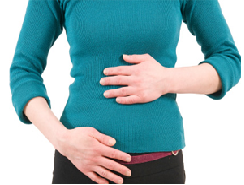Uterine Fibroids
Home / Female Health / Uterine Fibroids
Q: What is a Uterine Fibroids?
Uterine fibroids, also known as leiomyoma, are benign tumors that grow in the uterus.
Though they are termed as tumors due to their tendency to grow and multiply, they are not
cancerous and rarely, result in uterine cancer. However, they should not be neglected,
especially if they are not asymptomatic.
Q: What are the causes of fibroids?
What causes these fibroids to develop is still not known but hormones and family history
do play an important role. High levels of female hormones estrogen and progesterone especially
during menopause and pregnancy, increases the risk of fibroid growth. Also, nulliparous females
i.e. who haven't borne a child, early onset of menstruation before the age of 10, use of hormonal
therapy, high intake of alcohol or red meat, vitamin D deficiency and obesity makes one prone to the disease.

Q: What are the types of Uterine Fibroids
- Intramural fibroids: These most common type of fibroids develop in the endometrium which is the inner uterine lining, and tend to expand into the uterus giving it a bulky look.
- Subserosal: These grow within the outer layer of the uterus and thus, their expansion puts pressure on the adjoining pelvic organs such as bladder or rectum.
- Submucosal: The least common of all, submucosal fibroids grow within the innermost uterine lining and their growth may block the fallopian tubes and cause infertility.
- Pedunculated: Fibroids joined to the uterus by a stalk are known as pedunculated. They can be subserosal when growing on the outside, or submucosal on the inside of the uterus. The stalk may twist and cause pain or pressure.
Q: What are the symtoms of Uterine Fibroids??
Fibroids can range from the size of a pea to a huge ball, single or multiple in types
and thus, their treatment and symptoms varies accordingly. Some fibroids do not usually,
produce any symptom and shrink gradually on their own.
Common symptoms indicating fibroids are:
Common symptoms indicating fibroids are:
- Heavy menses or bleeding continuing for long
- Inter-menstrual bleeding
- Pelvic pain
- Frequent urination
- Pain during sex
- Passage of clots in between menses
- Enlarged abdomen
- Pressure in the abdomen
- Constipation
- Back pain
Q: What are the managements of Uterine Fibroids?
As mentioned above, management depends on the severity and location of the fibroids.
Some fibroids may not require any treatment, some dissolve with hormonal treatment while
others may require surgical intervention. Fibroids during pregnancy need to be monitored
more closely. Iron supplements may also be prescribed to prevent anemia from excessive blood loss.
Prognosis:
Fibroids are not usually dangerous or life-threatening but a biopsy of the removed tissue
is always advisable to confirm its benign nature. If trying to conceive, discussion with the
doctor is recommended.







